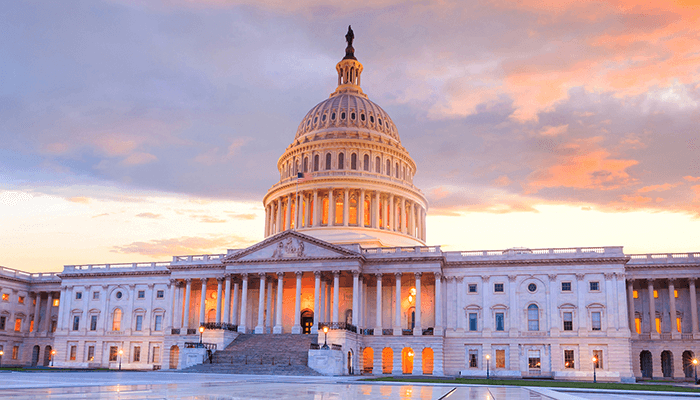What's in the House's Full-Year Continuing Resolution?
Update (3/13/2025): This piece has been updated to include an estimate of the Changes in Mandatory Programs (CHIMPs) without outlay savings, which result in the net effect of the bill to increase deficits by $7 billion over a decade.
The House of Representatives will soon vote on the Full-Year Continuing Appropriations and Extensions Act, 2025, which would fund the government under a continuing resolution (CR) for the remainder of Fiscal Year (FY) 2025. The Congressional Budget Office (CBO) estimates that this bill would set overall base discretionary budget authority for Fiscal Year (FY) 2025 at $1.600 trillion, with $893 billion for defense and $708 billion for nondefense.
Relative to a baseline using the original FY 2025 caps (Section 101) on base discretionary spending under the Fiscal Responsibility Act (FRA), we estimate this bill would reduce discretionary spending by $54 billion through FY 2034. However, because the bill continues rescissions to Internal Revenue Service (IRS) funding from FY 2024 appropriations – which will result in revenue losses – and includes $15 billion of Changes in Mandatory Programs (CHIMPs) without outlay savings, we estimate the net deficit impact of this bill is $7 billion of deficit increases through FY 2034.
The bill also contains about $4 billion of costs from extending health policies, which are completely offset by extending the 2 percent sequester on Medicare spending by an additional two months.
What’s in the House’s Full-Year Continuing Resolution?
| Policy | Ten-Year Cost/Savings (-) |
|---|---|
| Changes to Nondefense Discretionary Outlays (relative to FRA cap) | -$27 billion |
| Changes to Defense Discretionary Outlays (relative to FRA cap) | -$27 billion |
| IRS Rescission (net effect) | $46 billion |
| CHIMPs without Outlay Savings | $15 billion |
| Health Extenders | $4 billion |
| Medicare Sequester Extension | -$4 billion |
| Net Fiscal Impact | $7 billion |
Source: Congressional Budget Office, CRFB estimates.
Note: Above figures are for base funding only. Figures exclude interest.
The full-year CR is roughly equivalent to FY 2024 funding with a few anomalies, including the removal of all Congressionally Directed Spending (“earmarks”) and other smaller shifts in funding between appropriations titles (described in the table below). The net result is a $10 billion increase in funding above FY 2024 levels and roughly flat total funding between the previous two CRs and this one.
Budget Authority Allocations by Appropriations Title (billions)
| Appropriations Title | FY 2024 (Actual) | FY 2025 CR | Difference |
|---|---|---|---|
| Agriculture | $26.2 | $26.6 | $0.4 |
| Commerce, Justice, Science | $66.5 | $67.8 | $1.3 |
| Defense | $824.5 | $831.5 | $7.0 |
| Energy and Water | $58.2 | $58.1 | -$0.1 |
| Financial Services and General Government | $13.7 | $15.9 | $2.2 |
| Homeland Security | $61.8 | $65.0 | $3.2 |
| Interior and Environment | $38.6 | $40.9 | $2.3 |
| Labor, HHS, Education | $194.4 | $198.2 | $3.8 |
| Legislative Branch | $6.8 | $6.7 | -$0.1 |
| Military Construction, VA | $153.9 | $146.6 | -$7.3 |
| State, Foreign Operations | $55.8 | $56.8 | $1.0 |
| Transportation, HUD | $89.5 | $86.4 | -$3.1 |
| Total Base Funding | $1.59 trillion | $1.60 trillion | $10 billion |
Source: Congressional Budget Office.
Note: Above figures are for base funding only; title allocations are comparisons between CBO scores and do not necessarily reflect effective changes in funding due to differences in CHIMPs, offsetting receipts, and other rescissions. Numbers may not sum due to rounding.
Importantly, the full-year CR would put both defense and nondefense budget authority (BA) under the FRA’s Section 101 caps for 2025 by about $2.7 billion each. As a result, we estimate that direct outlay savings would total roughly $5.4 billion over the next decade. Relative to a baseline where Congress appropriates at the full level of the Section 101 FRA caps, we estimate that this bill would result in discretionary BA that is $61 billion lower than that baseline through 2034. This would result in $54 billion of outlay savings through 2034.
The FRA included a second set of caps (Section 102) that are put in place if Congress has not agreed to full-year appropriations by December 31, 2024. Those caps do not become binding until April 30, 2025, at which point a CR with appropriations above those caps would require a sequester to bring defense or nondefense spending in line with them. As a result, CBO’s current baseline assumes the Section 102 caps are binding for base discretionary spending, and appropriating above those caps would technically increase CBO’s baseline projections.
Lawmakers have reportedly agreed with the Administration (which would order such a sequester) to consider a full-year CR as full-year appropriations, which would make the Section 101 caps binding. However, if that were not to be the case, the defense total would violate the Section 102 caps and thus require a sequester of $42.7 billion to bring it into compliance.
Budget Authority in FY 2025 Under the CR vs. FRA
| Defense | Nondefense | Total | |
|---|---|---|---|
| Proposed Continuing Resolution | $892.5 billion | $708.0 billion | $1.600 trillion |
| FRA Section 101 2025 Caps | $895.2 billion | $710.7 billion | $1.606 trillion |
| Difference (from cap) | -$2.7 billion | -$2.7 billion | -$5.4 billion |
| FRA Section 102 Caps | $849.8 billion | $736.4 billion | $1.586 trillion |
| FRA Enacted 2024 Caps | $886.3 billion | $703.7 billion | $1.590 trillion |
Source: Congressional Budget Office.
Note: Above figures are for base funding only.
The full-year CR would also extend $20.2 billion of IRS funding rescissions from the FY 2024 appropriations. CBO estimates that the reduction in revenues attributable to the recession will total $66 billion over the FY 2025 to 2034 period. After accounting for the decreased IRS spending, this amounts to a $46 billion deficit increase. Additionally, the bill continues $15 billion of phony CHIMPs that would result in no outlay savings, which add to its costs. Combined with the savings from lower appropriations in 2025, we estimate a net cost of $7 billion through 2034.


